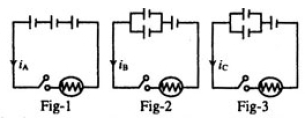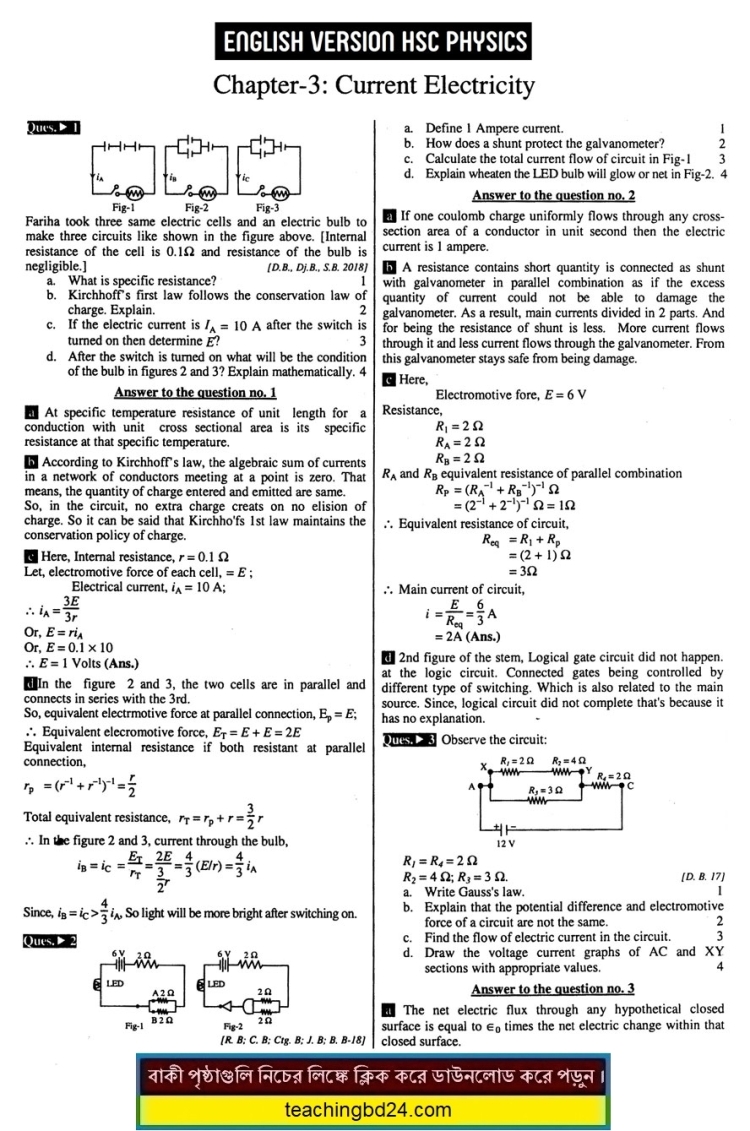English Version HSC 2nd Paper 3rd Chapter Physics Note. Current Electricity. The physics is one of the oldest academic disciplines, perhaps the oldest through the inclusion of astronomy. In the last two millennia, physics was a part of natural philosophy, chemistry, certain branches of mathematics and biology, but during the scientific revolution in the 17th century, the natural sciences emerged as unique in its own right research programs. Physics intersects with many interdisciplinary areas of research, such as Biophysics and quantum chemistry, and physics limits are not rigidly defined. New ideas in physics often explain the fundamentals of other sciences mechanisms, to open new avenues of research in areas such as mathematics and philosophy.

English Version HSC 2nd Paper 3rd Chapter Physics Note
Current Electricity
Question No.1
 Fariha took three same electric cells and an electric bulb to make three circuits like shown in the figure above. (Internal resistance of the cell is 0.12 and resistance of the bulb is negligible.)
Fariha took three same electric cells and an electric bulb to make three circuits like shown in the figure above. (Internal resistance of the cell is 0.12 and resistance of the bulb is negligible.)
a. What is specific resistance? 2
b. Kirchhoff’s first law follows the conservation law of charge. Explain. 2
c. If the electric current is IA= 10 A after the switch is turned on then determine E? 3
d. After the switch is turned on what will be the condition of the bulb in figures 2 and 3? Explain mathematically. 4
The answer to the question no. 1
a. At specific temperature resistance of unit length for a conduction with the unit cross sectional area is its specific resistance at that specific temperature.
b. According to Kirchhoff’s law, the algebraic sum of currents in a network of conductors meeting at a point is zero. That means, the quantity of charge entered and emitted are same. So, in the circuit, no extra charge creats on no elision of charge. So it can be said that Kirchho’fs 1st law maintains the conservation policy of charge.4
c. Here, Internal resistance, r=0.1 Ohm
Let, the electromotive force of each cell, = E;
Electrical current, iA= 10 A;
So, iA=3E/3r .: E=riA
Or, E = 0.1 x 10 .: E= 1 Volts (Ans.)
d. In figure 2 and 3, the two cells are in parallel and connect in series with the 3rd. So, equivalent electromotive force at the parallel connection, Ep=E;
.: Equivalent electromotive force, ET=E+E = 2E Equivalent internal resistance if both resistant at parallel connection, rp =r/2
Total equivalent resistance, rT=rP+r=3r/2
.: In figure 2 and 3, the current through the bulb,
iB = 4A/3
Physics is one of the oldest academic disciplines and, through its inclusion of astronomy, perhaps the oldest. Over the last two millennia, physics, chemistry, biology, and certain branches of mathematics were a part of natural philosophy, but during the scientific revolution in the 17th century, these natural sciences emerged as unique research endeavors in their own right. Physics intersects with many interdisciplinary areas of research, such as biophysics and quantum chemistry, and the boundaries of physics are not rigidly defined. New ideas in physics often explain the fundamental mechanisms studied by other sciences and suggest new avenues of research in academic disciplines such as mathematics and philosophy.
teachingbd24.com is such a website where you will get all kinds of necessary information regarding educational notes, suggestions and question patterns of schools, colleges, and madrasas. Particularly, you will get here special notes of physics that will be immensely useful to both students and teachers. The builder of the website is Mr. Md. Shah Jamal who has been serving for 32 years as an Assistant Professor of Physics at BAF Shaheen College Dhaka. He expects that this website will meet up all the needs of Bengali version learners /students. He has requested concerned students and teachers to spread this website home and abroad.
English Version HSC Physics Note
Discover more from Teaching BD
Subscribe to get the latest posts sent to your email.

